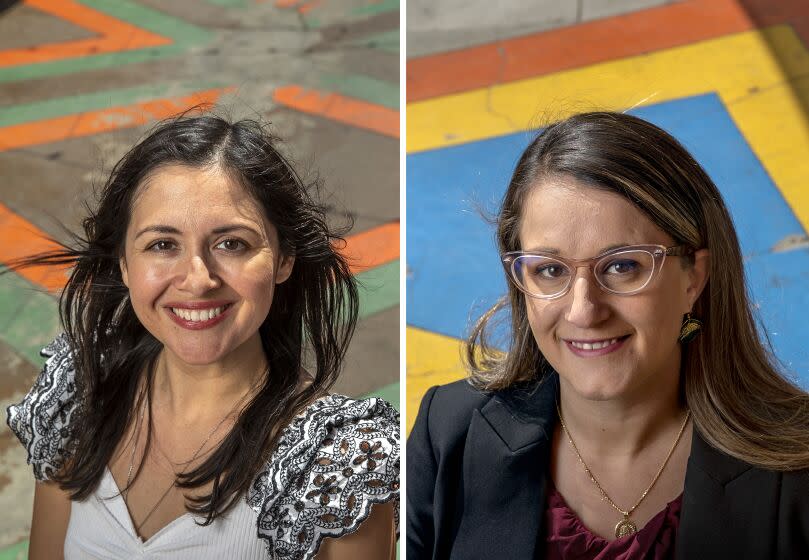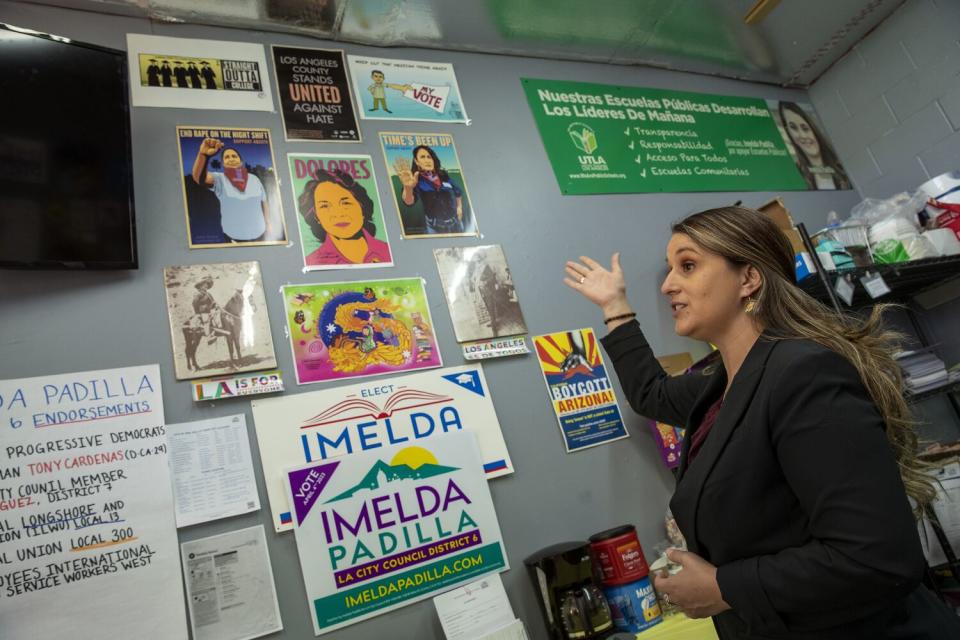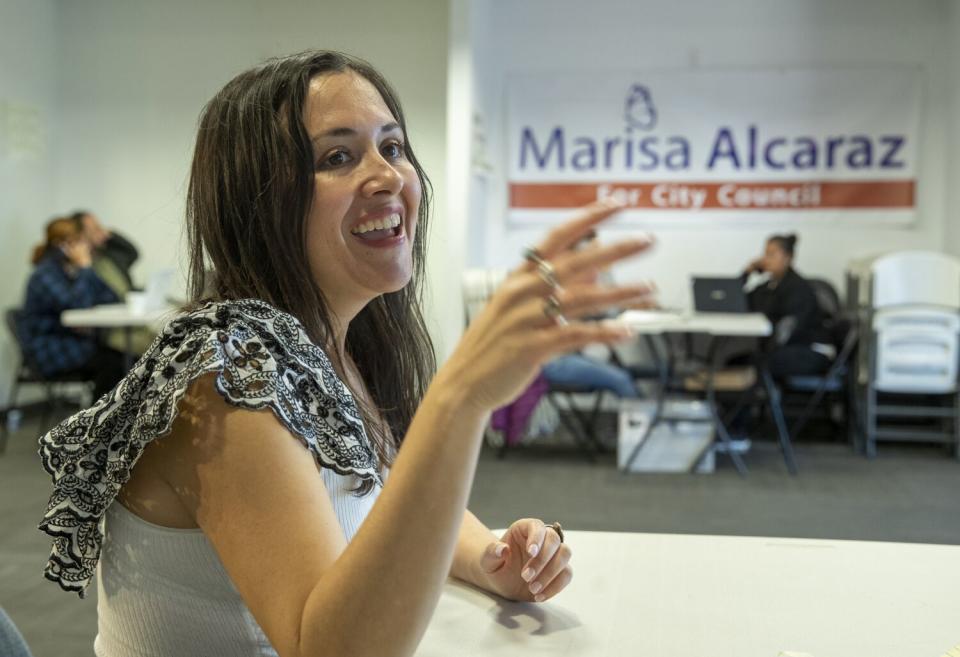Column: Whose San Fernando Valley will win? These two women seek to replace Nury Martinez

- Oops!Something went wrong.Please try again later.
- Oops!Something went wrong.Please try again later.
Plaza del Valle in Panorama City is one unlikely political battlefield.
Think of Olvera Street but bigger, brighter, livelier. Immigrants run barbershops, clothing boutiques and beauty salons. Restaurants sling out tacos, ice cream and Filipino food. Murals abound. Mariachi singers wander the block-long complex with portable speaker-microphones.
The plaza sits at the crossroads of Council District 6, the L-shaped swath of the San Fernando Valley that former Council President Nury Martinez ruled for nearly a decade until the release of a secretly recorded racist conversation last fall torpedoed her career. Her resignation upended city politics and led to an April 4 special election to choose her replacement.
Imelda Padilla and Marisa Alcaraz were the top two finishers, with only 11.4% of voters turning out, and will head into a June 27 runoff. Their choice for campaign headquarters? Plaza del Valle.
Each celebrated modestly on election night — Padilla on the north side of the plaza, Alcaraz on the south. But the tension between the two campaigns was palpable then and has ratcheted up since, because they seem so alike.
Both are millennial Mexican American women and lifelong residents of District 6 who left to attend a University of California school. Alcaraz is from middle-class Lake Balboa on the southern side of the district, and Padilla is from working-class Sun Valley on the eastern side.
They’re each running on a platform of public safety, reform and investment in long-neglected neighborhoods. They're both Democrats, credit their parents for their desire to make a difference in the world, and count prominent Valley Latinas as supporters — L.A. Councilmember Monica Rodriguez for Padilla and San Fernando Councilmember Cindy Montañez for Alcaraz.
The differences between the two candidates are few but telling. Padilla — who describes herself as a guerrera (a fighter) — is a longtime community organizer in the Valley who says her people-power approach is the type of outsider outlook that District 6 needs. Alcaraz, an admitted “policy nerd,” has spent the last decade as a staffer for South L.A. Councilmember Curren Price and touts that background as proof she can navigate City Hall.
I figured the best way to get to know them was for each to give me a tour of Plaza del Valle. I scheduled them for the same day, three hours apart.

When I arrived to meet Padilla at 9 in the morning, the promise and problems of District 6 were already apparent.
Stalls opened up for the day next to vacant spaces. Senior citizens lined up at a health clinic. Security guards walked around looking to shoo away homeless people. Four massive televisions outside a panaderia aired a soccer game to a rapt crowd.
Padilla's small office is next to a pet groomer. When I walked in, she was wiping up a puddle of water that had seeped in after a janitor power-washed the sidewalk. On the wall were Chicano art lithographs and campaign signs from Padilla’s failed 2017 run for the school board.
“I put those up to inspire us to not make the same mistakes that we made then,” she said, turning my attention to a map of District 6 on a desk decorated with Post-It notes.
Padilla beamed. “This is our plan to win now.”
She said Plaza del Valle is perfect as her base because many of the people she’s worked with on issues ranging from environmental racism to student mentorship live nearby. Besides, her family has visited the plaza since her teens.
"[The] plaza is a space of entrepreneurship,” said the 35-year-old. “It’s a place where families come to hang out because there’s so few public spaces around here. I wanted this specific office because the señoras can come in and see their kids play in the playground in front.
“The landlord offered me the space where Marisa now is,” she continued, now smiling. “$4,000 a month. This spot we’re in is only $1,000. All those savings, I’m using for the campaign.”
Plaza tenants greeted her as we started our tour. I asked why she was running, and Padilla brought up the tape that brought down Martinez, for whom she was a field deputy a decade ago.
“This happened in my community, and no way was I going to let the wrong person represent us again,” she replied as we walked toward Van Nuys Boulevard, where construction is slated begin this year on a light-rail extension that will cut through District 6.
“I’m running por la gente [for the people],” Padilla continued. “This district had been neglected and undervalued. Residents need more jobs, safer streets, better air. As the train gets built, there’ll be a lot of desire to redevelop all this. We just need to make sure it’s equitable.”
We stopped in front of La Tapachulteca, a large Salvadoran market. She was thrilled that a second location was opening in a former Coco's near Kaiser Permanente's Panorama City campus.
“There’s so much untapped potential here,” Padilla said, “it’s not even funny.”
After some tacos, we were back near Padilla's office when we saw a woman posing for photos in front of butterfly wings painted on a wall. It was Alcaraz.
There was an awkward silence, the kind that happens in westerns when gunslingers scheduled for a morning showdown accidentally cross paths the night before.
Alcaraz grinned. Padilla kept walking. “Ella es,” she finally whispered. That’s her.
Padilla supporters claim that Alcaraz is little more than a Price puppet who hasn’t done the work in District 6 that their candidate has. Alcaraz’s side counters that Padilla is a political novice beholden to the San Fernando Valley political machine that produced Martinez.
I asked Padilla about that charge.
“Over 20 years of the work here counts,” she calmly replied. “I’m not a stranger to this region. ‘Machines’ are something that people from the outside talk more about. Folks here vote for the individuals that do the work.”
I walked to Alcaraz’s headquarters. Her suite was about four times the size of Padilla’s and stood next to a Denny’s. Volunteers were making phone calls or typing on computers.

Alcaraz greeted me with an apologetic laugh.
“When I saw you guys, I’m like, ‘Oh no!’ ” Alcaraz said, holding a coffee-spiked horchata. “We were just having fun.”
It quickly became apparent as we toured Plaza del Valle that she wasn’t as familiar with it as was Padilla.
“We looked at the map and thought, ‘We need a central spot,” Alcaraz, 38, replied when I asked why she picked it. “My campaign manager worked across the street at the swap meet.
"This is a great place,” she continued. “But do you know about the Montgomery Ward?”
About a block away stood a long-abandoned outpost of the defunct department store chain that’s covered with graffiti.
“I’m not going to cast blame on why it’s been like that for so long," she said. "I just don’t think it’s acceptable to leave a property vacant for a couple of decades.”
A single mother to a kindergartner, Alcaraz got her start in politics as a staffer for Richard Alarcon, the pioneering Valley politician whose career ended in disgrace after a jury found him and his then-wife guilty of voter fraud for not living in the house where they were registered to vote (an appeals later overturned the convictions).
What did that scandal teach her?
“You have to stay humble and down to earth,” Alcaraz said. “Don’t let power and politics go to your head. You can’t get sucked into the political sphere. I need to be a role model for my daughter, so I would never do anything that she wouldn’t approve of.”
We were back at her sparsely decorated headquarters. She mentioned city policies championed by Price — a guaranteed basic income program, hero pay for grocery store workers, the decriminalization of street vendors — that she worked on. Price calls them “Marisa’s brainchildren," she said.
Alcaraz argued that those accomplishments, along how Price’s district has transformed during her time with him, showed what she could bring to the Valley.
“You didn’t see South Central as a place where people wanted to invest,” Alcaraz said. “But that’s not how it is anymore. That means a lot of jobs and housing. We also helped building up nonprofits to help the district and work with each other.
"I don’t see a lot of that in the Valley, she continued. "Everyone talks about coalition building and unity. That’s what I’ve been working on. Now, I can take all of that experience and bring it to this community,” she continued, “because it’s my community.”
What about insinuations that she’s a Curren clone?
“Anyone that cares for you and believes you and supports you is going to work with you,” she replied. “If they weren’t coming, wouldn’t that worry you a bit more? I obviously have a mind of my own. I find [the thought] offensive.”
We headed back to Plaza to eat pupusas. She boasted that the race was “trending toward us,” hinting that major endorsements from unions and some of her former opponents were coming her way.
Before we left, Alcaraz asked staffers if they also wanted some pupusas. I didn’t hear the full exchange, but I noticed the part where Alcaraz said, “I’ll do what I’m told.”
A volunteer jokingly scolded her. “No, we follow what you say. You’re the leader.”
Come June 27, voters will decide about that.
This story originally appeared in Los Angeles Times.

